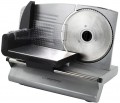Power
The total power consumption of the slicer. The value of this parameter is small — the performance of even the most powerful models usually does not exceed 200 W.
Almost all the power consumed is for operation of the engine, so the higher
it is, the more powerful the engine is installed in the slicer. Theoretically, the higher power allows you to better cope with solid and dense products, but in fact everything also depends on the characteristics of the knife — primarily its type (see below) and the quality of sharpening. Therefore, power data are more reference than practically significant, and this indicator has almost no effect on the quality of the slicer.
Speed control
The ability
to adjust the speed at which the slicer blade rotates. This allows you to further adjust the operating mode to the specifics of a particular situation and type of products: for example, the slicer can easily cope with relatively soft and homogeneous ingredients at low speed, but for solid, dense or heterogeneous it is better to use the “fast” mode.
Note that this function, on the one hand, is rarely required in everyday life, on the other hand, it significantly affects the cost of the device. Therefore, the presence of an adjustable speed is typical mainly for advanced slicers.
Protection from accidental activation
The presence
of protection from accidental activation in the design of the slicer.
One of the most popular options for such protection is the use of two power buttons: in order for the knife to move, you need to hold down both. This format of work minimizes the chance of accidental start — for example, if you touch the button while correcting the cut product in the immediate near the blades. In addition, this function can also play the role of child lock: the buttons are often made quite tight so that only an adult can press them.

